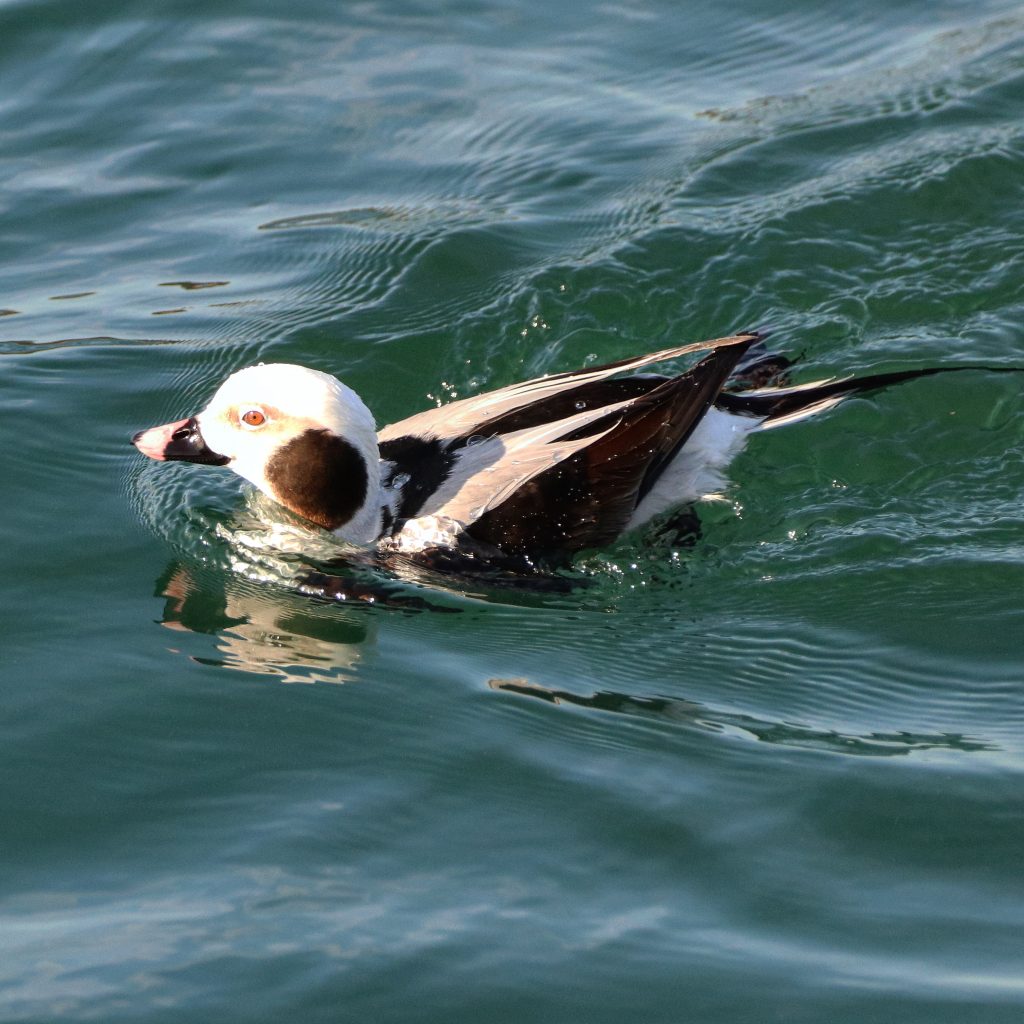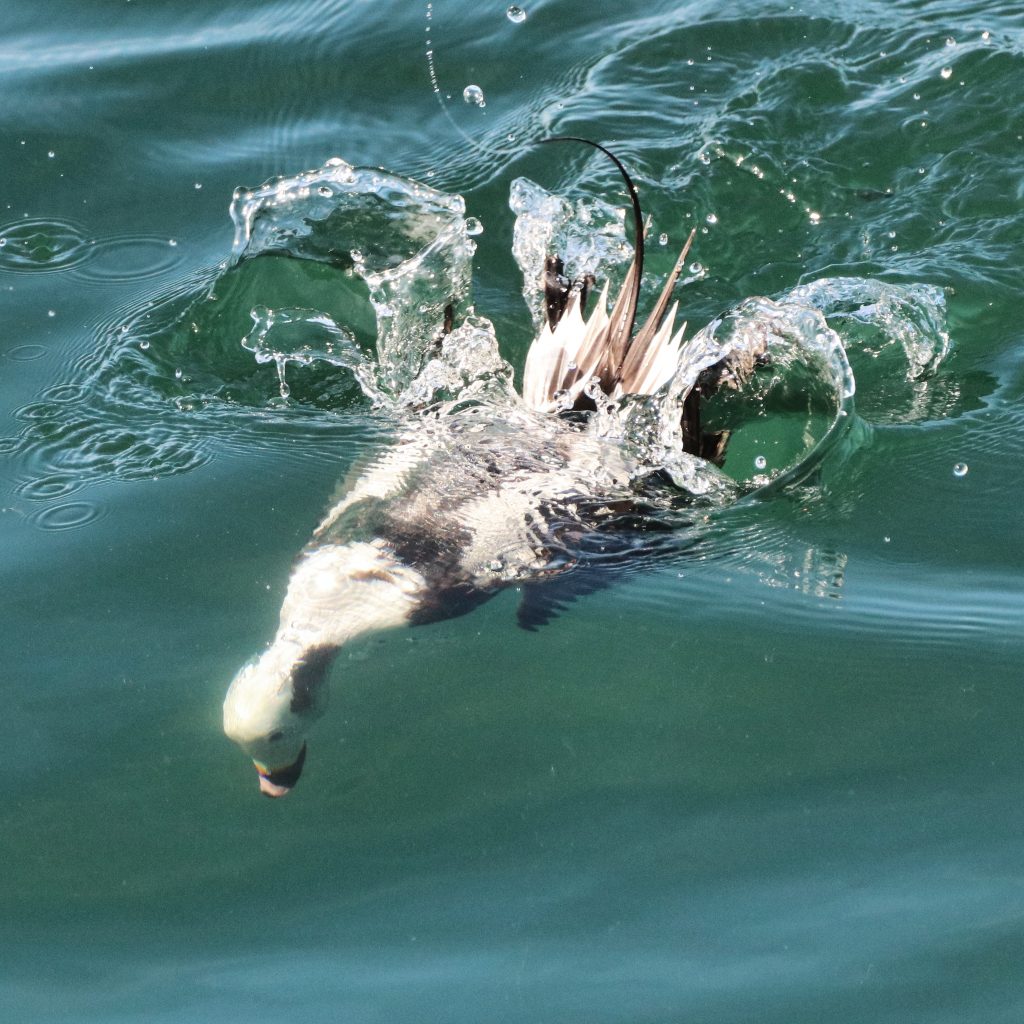Photos by Stewart Ting Chong
On a settled winter day, a trip along the east coast of Cape Ann, Mass., putting in at Rockport, will give you a sight of one of the most striking winter sea ducks along the Essex County coast, the Long-tailed Duck (Clangula hyemalis).
The ducks (formerly known as Old Squaw) summer and breed in the Arctic tundra in Canada but spend winters on open ocean here. You might see them in the company of eiders, scoters, Harlequin Ducks, Northern Pintails, loons, and Buffleheads. They tend to swim farther offshore so best to have your binoculars handy.
Seen up close, in non-breeding plumage, the male has two long slender black tail feathers, curling upwards, a white head with a large black smudge on its cheek, colors are black and white, with a brownish tan face. From the distance in a kayak, they will present mostly as black and white. The female has brown back and wings with a white head and smudgy brown cheek, the tail feathers are shorter than the male’s.
They may be easier to recognize in flight with a long tail, white collar, dark breast, and white belly. You can also recognize them while on the water by their distinct nasal yodel sound (their Latin name means wintry trumpets). While solitary and territorial in the arctic breeding grounds, they congregate, sometimes in great numbers in their winter habitat.
They fly low over the water, land, float on the surface, then dive and disappear for a long time. They are in search of food near the sea bottom. They eat their prey underwater before popping back up. What makes them unique among the winter ducks is that they are the deepest diving sea ducks. They feed mostly within 30 feet of the surface but are known to dive to depths of 200 feet. Count the time you see them underwater. They are known to hold their breath for 25-60 seconds.
Of the diving ducks, Long-tailed Ducks log the most time underwater. During foraging excursions, they spend three or four times as long underwater as on the surface, according to Cornell Labs.
Unlike other sea ducks, the Long-tailed Ducks flap their partly opened wings to propel downwards, in addition to paddling with their webbed feet. They also propel themselves actively back up to the surface.
They dive to the lower depths of the water column in search of crustaceans, mostly amphipods; or mollusks (blue mussels, clams, periwinkles); also a few small fish. In the summer breeding grounds on the tundra they eat mostly aquatic insects, crustaceans, mollusks, fish eggs, and plant material like grasses and pondweeds.
When observing them from shore around Bass Rocks in Gloucester, Mass., looking at a NOAA chart, I estimated the ducks were out in the 20-foot depth zone, or maybe the 40-foot zone, but a pair was near a depth transition zone of 5-15 feet closer to shore, which could imply an upwelling or disturbance of sea critters to feed on.
They may have been foraging on arthropods, small fish, or perhaps plucking mollusks off the rocky bottom with the use of chisel-shaped bills that curve up at the tip. flat, upturned bills.
While the ducks around Cape Ann like the bold, rocky shore, they also like sandy shoals. A study in Nantucket in 2009 observed that Long-tailed Ducks foraged over shallow depths (less than 65 feet) up to 43 miles offshore on the Nantucket Shoals. The study showed they ate primarily Gammarus annulatus, a pelagic crustacean amphipod, which is common, congregates in big groups, and is eaten by many fish and sea mammals.
In all, they look very much at home in this great expanse of the Atlantic just off the rocky shoreline at Bass Rocks.
Tips: Winter paddling is one of the most enjoyable activities. You have the quiet winter world to yourself and being able to observe sea ducks right from the water. But on a cautionary note, this east side of Cape Ann is wild and rocky, with open ocean, you will be dealing with refracting waves off the rocks, few landing spots, and no other boats around. As always when winter paddling, wear a wetsuit or drysuit and pick a settled day, listen to your weather radio to make sure no high winds are expected.
Put-in: Good Harbor Beach, Gloucester. Labor Day to Memorial Day you can launch a kayak from the beach. Plenty of public parking. From here it’s a short paddle south to Bass Rocks, and about 1.5 miles to the Ocean House Hotel. Another put-in to observe winter ducks along this coast is at Granite Pier in Rockport.
You can also see Long-tailed Ducks closer to shore along the Merrimack River near the Route 1 bridge in Newburyport, which makes for a less exposed paddle. You can put in at Cashman Park, in Newburyport, then turn right and take a short paddle down the river toward downtown. At the Route 1 Bridge, you may see the pair of Peregrine Falcons that have been nesting in a man-made box since 2018. From Cashman Park, you can also turn left and follow the Merrimack up to Maudslay State Park, about a 2.5-mile paddle one way, to see the many Bald Eagles that winter here. Try to time these trips with the tides.


